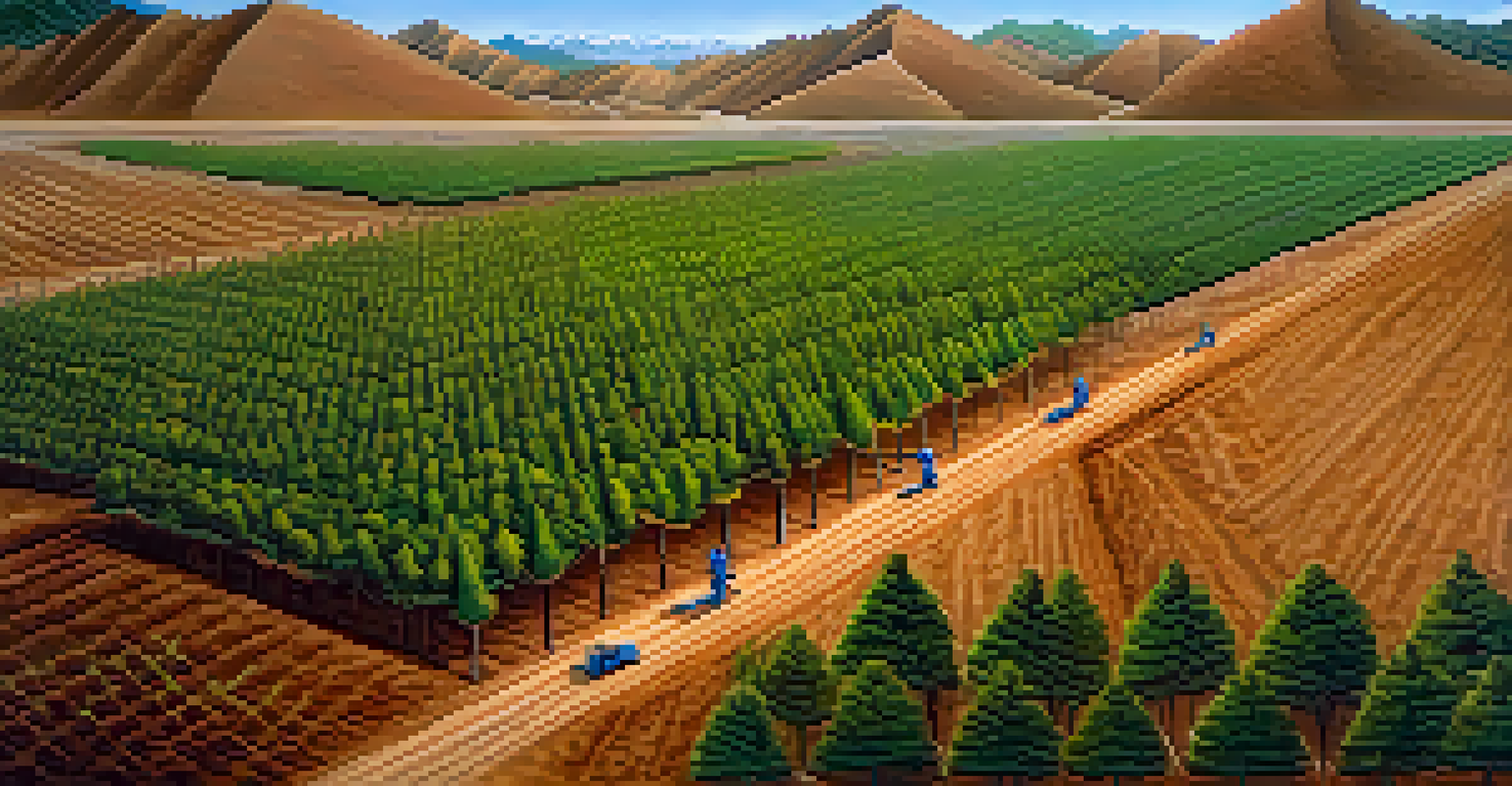How Deforestation Affects Plant Biodiversity and Climate Change

Understanding Deforestation and Its Causes
Deforestation refers to the large-scale removal of trees from forests, leading to significant ecological changes. This often occurs due to agricultural expansion, urban development, and logging activities. As we clear vast areas of forest, we strip the land of its natural ecosystems, which play a critical role in maintaining biodiversity.
The best time to plant a tree was twenty years ago. The second best time is now.
The primary drivers of deforestation include economic growth and the demand for land to cultivate crops or raise livestock. This relentless pursuit of resources often overlooks the long-term consequences on the environment and our climate. For instance, in countries like Brazil and Indonesia, vast tracts of rainforest are cleared annually, significantly impacting local and global biodiversity.
By understanding the causes of deforestation, we can better appreciate its profound implications. Recognizing that our choices, from the products we buy to the foods we consume, contribute to deforestation can empower us to make more sustainable decisions.
The Impact of Deforestation on Plant Biodiversity
Plant biodiversity refers to the variety of plant species within a given area, and it is crucial for maintaining healthy ecosystems. When forests are cut down, the habitats that support countless plant species are destroyed, leading to a decline in biodiversity. This loss can disrupt the balance of ecosystems, affecting everything from soil health to water cycles.

For example, the Amazon rainforest is home to over 40,000 plant species, many of which are not found anywhere else on Earth. As deforestation continues, we risk losing unique species that could offer medicinal benefits or contribute to ecological stability. The more biodiversity we lose, the more vulnerable ecosystems become to diseases and climate change.
Deforestation Threatens Biodiversity
The large-scale removal of trees disrupts ecosystems, leading to a decline in plant species and threatening the balance of nature.
Moreover, diminished plant biodiversity can lead to a cascade of effects on the entire food chain, impacting not only plants but also the animals and humans that depend on them. This interconnectedness highlights the importance of preserving forest ecosystems for the sake of our planet's health.
How Deforestation Contributes to Climate Change
Forests play a vital role in regulating the Earth's climate by absorbing carbon dioxide (CO2) from the atmosphere. When trees are felled, the stored carbon is released back into the atmosphere, contributing to the greenhouse effect. This exacerbates climate change, leading to more extreme weather patterns, rising temperatures, and altered ecosystems.
What we are doing to the forests of the world is but a mirror reflection of what we are doing to ourselves and to one another.
In fact, deforestation accounts for nearly 10% of global greenhouse gas emissions. The loss of forests not only reduces our planet's capacity to absorb CO2 but also disrupts local climates. For instance, areas that were once lush and green can become arid and uninhabitable due to changes in rainfall patterns caused by deforestation.
Thus, tackling deforestation is essential for mitigating climate change. By protecting and restoring forests, we can enhance their ability to sequester carbon, ultimately contributing to a more stable climate.
The Role of Forests in Ecosystem Services
Forests provide multiple ecosystem services that are crucial for life on Earth, such as clean air, water filtration, and soil stabilization. These services are often taken for granted until they are compromised. When deforestation occurs, we not only lose trees but also the myriad benefits they offer to both the environment and human society.
For example, trees play a pivotal role in the water cycle by absorbing rainfall and releasing moisture back into the atmosphere. Deforestation disrupts this cycle, leading to issues like increased flooding and soil erosion. Without trees to anchor the soil, land degradation becomes a pressing concern, affecting agriculture and water quality.
Forests and Climate Change Link
Forests play a vital role in carbon absorption, and their destruction significantly contributes to climate change by releasing stored carbon.
Recognizing the value of these ecosystem services can motivate communities and governments to prioritize forest conservation. Protecting forests means preserving the benefits they provide, ensuring a healthier planet for future generations.
The Interconnectedness of Plant Species and Climate
Plant species are not isolated entities; they exist within a network of relationships that support the ecosystem as a whole. Each species plays a unique role, whether it’s providing food for animals, contributing to soil health, or influencing local climate conditions. Deforestation disrupts these connections, leading to wider ecological imbalances.
For instance, certain plants are essential for maintaining soil integrity and preventing erosion. When these plants are removed, the soil can degrade rapidly, leading to reduced agricultural productivity. Furthermore, the loss of specific plant species can also impact pollinators, which rely on diverse flora for food.
This interconnected web highlights the importance of preserving plant biodiversity not just for its own sake but also for the stability of our climate. A diverse plant community can better adapt to changing conditions, providing resilience against climate change.
Actions to Combat Deforestation and Protect Biodiversity
Addressing deforestation requires a multifaceted approach, combining conservation efforts with sustainable practices. One effective strategy is reforestation, which involves planting new trees in areas where forests have been cut down. This not only restores habitats but also helps sequester carbon dioxide from the atmosphere.
Additionally, promoting sustainable agriculture can reduce the pressure on forests. Practices like agroforestry, which integrates trees into farming systems, can provide food and income while preserving biodiversity. Encouraging consumers to choose sustainably sourced products also plays a crucial role in reducing demand for deforestation-linked goods.
Sustainable Practices Are Essential
Adopting sustainable practices, such as reforestation and responsible sourcing, is crucial for protecting forests and ensuring ecological balance.
Ultimately, collective action at individual, community, and governmental levels is vital. By raising awareness and supporting policies that protect forests, we can take significant steps toward preserving biodiversity and mitigating climate change.
The Importance of Sustainable Practices for the Future
Sustainable practices are essential for ensuring the health of our planet and its ecosystems. By adopting methods that prioritize ecological balance, we can work toward a future where both humans and nature thrive. This means shifting away from practices that harm our forests and embracing those that promote sustainability.
For example, businesses can adopt sustainable sourcing practices, while individuals can support local and sustainable products. Education also plays a crucial role in fostering a culture of conservation, encouraging people to understand the importance of forests and biodiversity.

By prioritizing sustainability, we can create a positive feedback loop: healthier ecosystems lead to a stable climate, which in turn supports human well-being. Investing in our planet today is an investment in a better tomorrow for future generations.